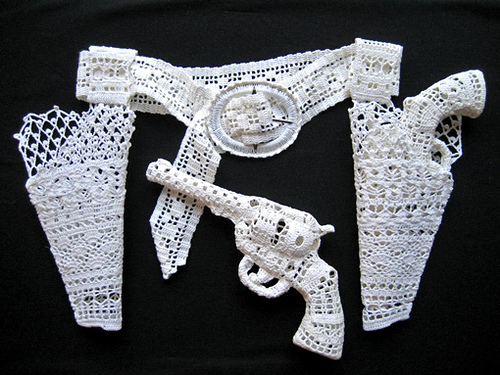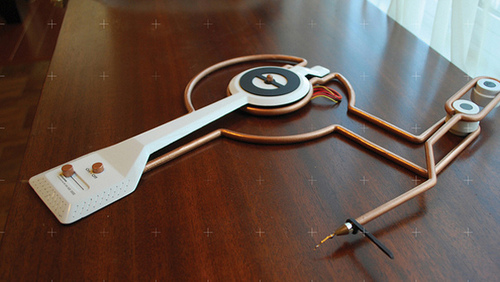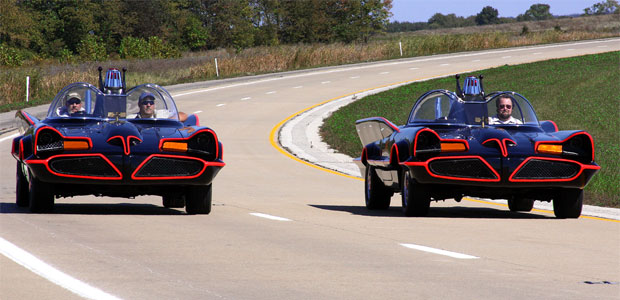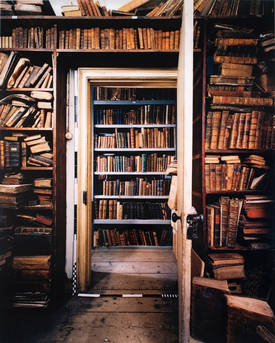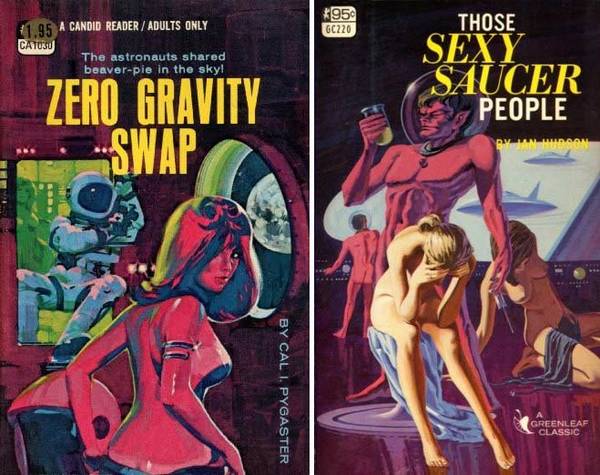Neatorama.
Sunday, January 30, 2011
Friday, January 28, 2011
The Tottenham Outrage
I missed the one-hundred-and-second anniversary of the Outrage, which was last Sunday.
On January 23, 1909, two armed robbers attempted a payroll heist (a "wages robbery" in Anglospeak) in the Tottenham neighborhood of London. The two unarmed victims resisted and the robbers opened fire. Hearing the gunshots, two constables ran to the scene, only to come under fire themselves. A civilian came to the rescue, and he was shot twice. The robbers fled on foot, pursued by half a dozen constables and several civilians.
Thus began a wild, almost comical, pursuit and shootout all over Tottenham. The police, being unarmed, rushed back to the station house to get the two .450 Webley gate-load revolvers stored there, but "the key to the firearms cupboard had been mislaid." Nevertheless the police continued their unarmed pursuit as the robbers fired at them. One robber was armed with a 6.5mm model 1894 Bergmann pistol and the other with a .32 Browning, both autoloaders.
Passersby joined the chase and produced their own pistols from pockets and cases. One officer, Constable Bond, borrowed a revolver from a passerby and returned fire. Other officers did likewise. A motorcar was brought into the pursuit, but as it closed on the robbers they turned and fired and "a fusillade of shots" disabled the car. It was here that the first fatality occurred: ten-year-old Ralph Joscelyn was hit in the chest and was dead on arrival at the hospital.
The officers guessed correctly that the robbers were heading for the Tottenham Marshes, and two constables, Newman and Tyler, sprinted ahead to cut them off. When they confronted the robbers and demanded their surrender, Tyler was fatally shot in the head.
As the superintendent's report later put it, "The chase which had now become most desperate was continued with splendid determination." Two duck hunters from Tottenham Marshes now joined the pursuit, using their shotguns to fire at the fleeing robbers. Several other civilians used their own pocket pistols to fire at the robbers as they ran through a gypsy camp and on to Chingford Road. Here they hijacked the Number 9 tram and forced the conductor to drive with a gun to his head.
 "By Gad, sir! There will be a letter about this in tomorrow's Times!"
"By Gad, sir! There will be a letter about this in tomorrow's Times!""Just drive, Eengleesh peeg!"
Sargeant Hales stopped the tram traveling in the opposite direction and ordered the conductor to reverse and follow. Many of the pursuers boarded the tram and there was a prolonged (and ineffective) exchange of gunfire with the robbers.
Leaving the tram, the robbers commandeered a horse-drawn milk cart, then a horse and van. The pursuers by now had brought several automobiles into the chase and were closing the gap. The robbers abandoned the van and continued on foot. At this point one of the robbers, apparently exhausted and having only a few more rounds of ammunition, decided to kill himself with a shot to the head. His accomplice entered Oak Cottage, the home of the Rolstone family. From here he traded shots with the crowd until three armed constables entered the house and cornered him, whereupon he, too, shot himself.

In all, two were killed and twenty-five wounded. During the two-hour, six-mile pursuit the robbers were said to have fired over 400 rounds.
On January 29th, funerals were held for both of the victims. Half a million people and 3,000 police officers lined the funeral route. Both victims were buried in Abney Park Cemetary, just a yard apart.

Ralph Joscelyne's mother kept the shoes that her son had been wearing on the day he was killed. When she died fifty years later, in accordance with her wishes, the shoes were buried with her.

The reason that this story should interest us today is that it shows that one hundred years ago many Londoners routinely carried handguns as they went about their daily business. In fact, the civilians were much better armed than the police. And yet there were very few murders in England and Wales. The first gun control law in Britain was the Gun Licence Act of 1870, which was a revenue-generating measure (10 shillings a year) but since there was no gun registration, it could not be enforced - and it wasn't. The fact is that the murder rate in the UK today - the number of murders per 100K population - is higher now than it was one hundred years ago.
Wednesday, January 26, 2011
Tuesday, January 25, 2011
Monday, January 24, 2011
Decimation
 I was trying to come up with a good pun for a title, but this is the best I could do.
I was trying to come up with a good pun for a title, but this is the best I could do.I drove down to Glen Allen to check out Green Top Sporting Goods. GT is a venerable gun-and-tackle store and over the years I've bought a lot of things from them. Today the excuse for my visit was to get some 10mm ammo. But there was none to be had!
Green Top does have some interesting history in a display case: one of their first bills of sale for a firearm, from 1956, when they were called "Green Top Service Station." And, from December 16, 1968, their very first form 4473.
So, I consoled myself with a couple boxes of .30 Carbine and moved on.
Moved on up the street about two miles to the Bass Pro Shops Superstore shown above. But they were out of 10mm, too. So I had lunch in their Islamorada Fish House and watched the tropical fish in their aquarium.
 So, any improvements on the word "decimation" to indicate a lack of 10mm?
So, any improvements on the word "decimation" to indicate a lack of 10mm?Friday, January 21, 2011
Turing, Enigma and Computing
Fascinating and entertaining lecture by Richard Buckland of the University of New South Wales, Australia.
Colossus
I just finished reading this book about WWII codebreaking at the legendary Bletchley Park site in England. The cracking of the Enigma codes is well known, but BP also worked on another Nazi cipher system that the Brits code-named "Fish". This was a family of encrypted teletype machines using 5-bit baudot code (32 characters, or, actually, 31 characters and one "null" symbol).
The Enigma machines used three or four 26-contact wired wheels to scramble the text. The Fish machines used 12 wheels, all of different sizes, all of which were co-prime (i.e. not sharing any factors) to produce an enormously long pseudo-random key sequence. This 5-bit key, added to the 5-bit plaintext in the "exclusive-or" (XOR) manner, produced the ciphertext. To decipher, the recipient just added the key to the ciphertext in the XOR manner to reproduce the plaintext. All of this was done automatically, using punched paper tape. The Fish machines could be hooked up to landlines or connected to a radio transmitter, and the latter is how BP came to intercept them.
The Brits cleverly deduced how the machine was designed without ever having seen one and devised ingenious paper-and-pencil methods to break the code and read the plaintext. The Nazis changed the key every day at midnight, and the BP nightshift would desperately try to extract the key. Once the key was known, any intercept that day could be decoded using the "Fish" analogue machines built at BP. Most of the cryptanalysts at BP rarely saw a decrypted message; they didn't have to. They were interested in extracting the key.
But as the war progressed, the Nazis continually upgraded the security on the "Fish" until BP's paper-and-pencil solutions were taking several days, then several weeks to complete. This was costing Allied lives, so automated methods were devised, the first being "Heath Robinson" devices (we would call them "Rube Goldberg" machines). These were high-speed paper tape readers that could run two message tapes synchronously at about 30-mph and compare them for statistical anomalies. This put BP back in the business of reading the messages on a daily basis, for a while.
Better operator security eventually outran the Heath Robinsons, and an all-electronic method was suggested by Thomas Flowers, on loan to BP from the British telephone system, where he had designed and installed the first all-electronic telephone switching system in Britain. Flowers designed the first Colossus computer, a 1500-tube (the Brits call them "valves") behemoth, to search for statistical anomalies a thousand times faster than the Heath Robinsons. The "Colossi" were built on an emergency basis, 'round the clock, the men literally sleeping in the shop when they weren't working. There were eventually eleven Colossus machines. Flowers was already designing improvements into the next unit before its predecessor was out the door. The last Colossus was delivered to BP just as the war was ending.
The most interesting thing I gathered from the book is that the legendary mathematician Alan Turing was not involved in the design or operation of the Colossus at all. He worked on Enigma codes only.
 This color photo is of a modern replica of a WWII Colossus at Bletchley Park, all of the originals having been destroyed at the end of the war (Churchill is said to have specifically ordered that they be broken down into "pieces no bigger than a man's hand"). Although there are rumors that one or two may have survived at GCHQ or NSA, and used for training. After the war, captured Fish machines were used by the French and also by the East German "Stasi", which considered them unbreakable. They were phased out in the 1960s.
This color photo is of a modern replica of a WWII Colossus at Bletchley Park, all of the originals having been destroyed at the end of the war (Churchill is said to have specifically ordered that they be broken down into "pieces no bigger than a man's hand"). Although there are rumors that one or two may have survived at GCHQ or NSA, and used for training. After the war, captured Fish machines were used by the French and also by the East German "Stasi", which considered them unbreakable. They were phased out in the 1960s.
The level of secrecy imposed by the British Official Secrets Act makes the American NSA look like a relative blabbermouth: details of the Colossus were not declassified by the Brits until October 2000. At the end of the war, the British cryptographers wrote a secret report on their work, knowing that it would not be released during their lifetimes. It included this rather poignant description of the Colossus:
UPDATE: My prayers have been answered:
The Enigma machines used three or four 26-contact wired wheels to scramble the text. The Fish machines used 12 wheels, all of different sizes, all of which were co-prime (i.e. not sharing any factors) to produce an enormously long pseudo-random key sequence. This 5-bit key, added to the 5-bit plaintext in the "exclusive-or" (XOR) manner, produced the ciphertext. To decipher, the recipient just added the key to the ciphertext in the XOR manner to reproduce the plaintext. All of this was done automatically, using punched paper tape. The Fish machines could be hooked up to landlines or connected to a radio transmitter, and the latter is how BP came to intercept them.
The Brits cleverly deduced how the machine was designed without ever having seen one and devised ingenious paper-and-pencil methods to break the code and read the plaintext. The Nazis changed the key every day at midnight, and the BP nightshift would desperately try to extract the key. Once the key was known, any intercept that day could be decoded using the "Fish" analogue machines built at BP. Most of the cryptanalysts at BP rarely saw a decrypted message; they didn't have to. They were interested in extracting the key.
But as the war progressed, the Nazis continually upgraded the security on the "Fish" until BP's paper-and-pencil solutions were taking several days, then several weeks to complete. This was costing Allied lives, so automated methods were devised, the first being "Heath Robinson" devices (we would call them "Rube Goldberg" machines). These were high-speed paper tape readers that could run two message tapes synchronously at about 30-mph and compare them for statistical anomalies. This put BP back in the business of reading the messages on a daily basis, for a while.
Better operator security eventually outran the Heath Robinsons, and an all-electronic method was suggested by Thomas Flowers, on loan to BP from the British telephone system, where he had designed and installed the first all-electronic telephone switching system in Britain. Flowers designed the first Colossus computer, a 1500-tube (the Brits call them "valves") behemoth, to search for statistical anomalies a thousand times faster than the Heath Robinsons. The "Colossi" were built on an emergency basis, 'round the clock, the men literally sleeping in the shop when they weren't working. There were eventually eleven Colossus machines. Flowers was already designing improvements into the next unit before its predecessor was out the door. The last Colossus was delivered to BP just as the war was ending.
The most interesting thing I gathered from the book is that the legendary mathematician Alan Turing was not involved in the design or operation of the Colossus at all. He worked on Enigma codes only.
The level of secrecy imposed by the British Official Secrets Act makes the American NSA look like a relative blabbermouth: details of the Colossus were not declassified by the Brits until October 2000. At the end of the war, the British cryptographers wrote a secret report on their work, knowing that it would not be released during their lifetimes. It included this rather poignant description of the Colossus:
It is regretted that it is not possible to give an adequate idea of the fascination of a Colossus at work; its sheer bulk and apparent complexity; the fantastic speed of thin paper tape round the glittering pulleys; the childish pleasure of not-not, span, print main header and other gadgets; the wizardry of purely mechanical decoding letter by letter (one novice thought she was being hoaxed); the uncanny action of the typewriter in printing the correct scores without and beyond human aid; the stepping of the display; periods of eager expectation culminating in the sudden appearance of the longed-for score; and the strange rhythms characterizing every type of run: the stately break-in, the erratic short run, the regularity of wheel-breaking, the stolid rectangle interrupted by the wild leaps of the carriage-return, the frantic chatter of a motor run, even the ludicrous frenzy of hosts of bogus scores.I wonder what it sounded like?
UPDATE: My prayers have been answered:
Oscar Levant
 One of my favorite "footnote people" of the 20th century. One of his movies (Humoresque, 1946) is on TCM right now, which started me on a Wiki-wander. It seems Levant had a live TV show in the late 1950's:
One of my favorite "footnote people" of the 20th century. One of his movies (Humoresque, 1946) is on TCM right now, which started me on a Wiki-wander. It seems Levant had a live TV show in the late 1950's:The show was highly controversial, eventually being taken from the air after a comment about Marilyn Monroe's conversion to Judaism: "Now that Marilyn Monroe is kosher, Arthur Miller can eat her". He later stated that he "hadn't meant it that way". Several months later, the show began to be broadcast in a slightly revised format—it was taped in order to provide a buffer for Levant's antics. This, however, failed to prevent Levant from making comments about Mae West's sex life that caused the show to be canceled for good.
He was also quoted:
"The only difference between the Democrats and the Republicans is that the Democrats allow the poor to be corrupt, too."
and
"Everyone in Hollywood is gay, except Gabby Hayes — and that's because he is a transvestite."
He titled his autobiography (one of three of them) Memoirs Of An Amnesiac.
I remember seeing him on the old Jack Paar Show. Quite a raconteur. He died in 1972.
Thursday, January 20, 2011
Telegraph Codes For Farmers
 To reduce telegraph charges, American farmers used these codes in 1906. Quote: "These, my children, are the LOLs and WTFs of our farming ancestors."
To reduce telegraph charges, American farmers used these codes in 1906. Quote: "These, my children, are the LOLs and WTFs of our farming ancestors."via Boing-boing.
Wednesday, January 19, 2011
The Fellowship Of The Ping!

I cracked open a case of Greek .30-06 and headed to the NRA range this evening.
 But I spent the first hour wandering the NRA museum. Here's the Star Model B used by William Holden in The Wild Bunch.
But I spent the first hour wandering the NRA museum. Here's the Star Model B used by William Holden in The Wild Bunch.
 Here's the H&K pistol used by Tom Cruise in Collateral.
Here's the H&K pistol used by Tom Cruise in Collateral.
 And the gun used by the mysterious Kaiser Soze in The Usual Suspects.
And the gun used by the mysterious Kaiser Soze in The Usual Suspects.
But the highlight was the Peterson collection, just added to the museum. Check out this Holland and Holland double rifle in .700 H&H:
 You would think that the recoil from one of those monster rounds would loosen the gold inlays!
You would think that the recoil from one of those monster rounds would loosen the gold inlays!
There were THREE Fabbri shotguns, the most incredible shotguns in the world. This one featured bulino engraving of nudes and peacock feathers, visible through the magnifier:

When I got to the range, I tried to get a recording of the Garand. It is loud!
 And ahhhh! the fragrance of 41-year-old military gunpowder! I fired forty rounds and no problems. This Garand was made in May, 1945 and has an unrelieved op-rod, but I am loathe to have it altered. The rifle fired about 3" to the right at 150 feet, which is the fault of the front sight being out of adjustment. It was caked with cosmoline when I got it from the CMP. I'm not complaining!
And ahhhh! the fragrance of 41-year-old military gunpowder! I fired forty rounds and no problems. This Garand was made in May, 1945 and has an unrelieved op-rod, but I am loathe to have it altered. The rifle fired about 3" to the right at 150 feet, which is the fault of the front sight being out of adjustment. It was caked with cosmoline when I got it from the CMP. I'm not complaining!
The NRA Range has new target gadgets with touch-screen controls, very high-tech. Now they need an iPhone app.
This is a Borchardt pistol, but what's that little wood-grained thingie in the lower left, that looks a bit like a magazine?

 But I spent the first hour wandering the NRA museum. Here's the Star Model B used by William Holden in The Wild Bunch.
But I spent the first hour wandering the NRA museum. Here's the Star Model B used by William Holden in The Wild Bunch. Here's the H&K pistol used by Tom Cruise in Collateral.
Here's the H&K pistol used by Tom Cruise in Collateral. And the gun used by the mysterious Kaiser Soze in The Usual Suspects.
And the gun used by the mysterious Kaiser Soze in The Usual Suspects.But the highlight was the Peterson collection, just added to the museum. Check out this Holland and Holland double rifle in .700 H&H:
 You would think that the recoil from one of those monster rounds would loosen the gold inlays!
You would think that the recoil from one of those monster rounds would loosen the gold inlays!There were THREE Fabbri shotguns, the most incredible shotguns in the world. This one featured bulino engraving of nudes and peacock feathers, visible through the magnifier:

When I got to the range, I tried to get a recording of the Garand. It is loud!
 And ahhhh! the fragrance of 41-year-old military gunpowder! I fired forty rounds and no problems. This Garand was made in May, 1945 and has an unrelieved op-rod, but I am loathe to have it altered. The rifle fired about 3" to the right at 150 feet, which is the fault of the front sight being out of adjustment. It was caked with cosmoline when I got it from the CMP. I'm not complaining!
And ahhhh! the fragrance of 41-year-old military gunpowder! I fired forty rounds and no problems. This Garand was made in May, 1945 and has an unrelieved op-rod, but I am loathe to have it altered. The rifle fired about 3" to the right at 150 feet, which is the fault of the front sight being out of adjustment. It was caked with cosmoline when I got it from the CMP. I'm not complaining!The NRA Range has new target gadgets with touch-screen controls, very high-tech. Now they need an iPhone app.
This is a Borchardt pistol, but what's that little wood-grained thingie in the lower left, that looks a bit like a magazine?

Tuesday, January 18, 2011
Supreme Court Declines Case
Greg Revell, flying from Salt Lake City to Allentown, Pennsylvania, was stranded at the Newark, NJ airport with his unloaded, locked, cased, licensed (Utah CHL) handgun in his checked baggage. He spent the night in a hotel but when he went to the airport the next morning to catch the next flight out he was arrested for unlawful possession of a firearm. Revell pointed out that he was legal at home and legal at his destination and that the gun was unloaded and locked up. The cops said that because Revell had the key to the lockbox (as required by TSA) he was "in possession" of the gun. He spent ten days in jail before he could post bond. Charges were eventually dropped and three years later his gun was returned.
Revell was seeking permission to file a civil suit against the Port Authority of New York and New Jersey. He lost every step of the way and today the U.S. Supreme Court denied his petition.
Pity. But there will be other battles.
Yahoo News.
Revell was seeking permission to file a civil suit against the Port Authority of New York and New Jersey. He lost every step of the way and today the U.S. Supreme Court denied his petition.
Pity. But there will be other battles.
Yahoo News.
Friday, January 14, 2011
Wednesday, January 12, 2011
First, The Good News
The good news is that insurance giant AIG announced today that it will be able to pay back the federal government bail-out in full.
The bad news is that my children will work their whole lives to pay back their part of the federal debt.
The bad news is that my children will work their whole lives to pay back their part of the federal debt.
Range Time
I went to Sharp Shooters pistol range (formerly Gilbert's Small Arms) on Monday with three or four objectives in mind. One, to test three new Wilson Combat magazines for the little Kimber .45 - they worked great.
Two, to get some trigger time for the Springfield 1911 9mm and the Papoose. No problems.
And three, to do more testing with the iPhone shot timer. This didn't work out so well.
The first thing to do is calibrate the unit's shot-sound threshold for each caliber, like this:

 S = Start and E = End. The PPK is a .32ACP, by the way.
S = Start and E = End. The PPK is a .32ACP, by the way.
There were too many other shooters and the din was incredible. The unit couldn't pick out my .22 from the .357's blasting all around me.
Two, to get some trigger time for the Springfield 1911 9mm and the Papoose. No problems.
And three, to do more testing with the iPhone shot timer. This didn't work out so well.
The first thing to do is calibrate the unit's shot-sound threshold for each caliber, like this:

 S = Start and E = End. The PPK is a .32ACP, by the way.
S = Start and E = End. The PPK is a .32ACP, by the way.There were too many other shooters and the din was incredible. The unit couldn't pick out my .22 from the .357's blasting all around me.
Tuesday, January 11, 2011
Dude, Where's My Urchin Diver?
From a restaurant review in the NYT:
Willows Inn, on the tiny San Juan island of Lummi, is about two hours from Seattle by car and ferry. Yet it is about to become a destination restaurant, thanks to its new chef, Blaine Wetzel. The 24-year-old, formerly the protégé of Rene Redzepi at Noma, the Copenhagen restaurant that was ranked the “best restaurant in the world” for 2010 by S. Pellegrino, took over the kitchen at Willows last year. The restaurant itself reopens in February; expect a menu with an obsessive focus on local ingredients, in the style of Noma. Since he was hired, Mr. Wetzel has been working with a farmer and an urchin diver who work solely for him.
Friday, January 7, 2011
Top Ten Bookstore Cats
 This is #6, Asimov. He lives at Seek Books in West Roxbury, Mass. The store specializes in science fiction, fantasy and horror.
This is #6, Asimov. He lives at Seek Books in West Roxbury, Mass. The store specializes in science fiction, fantasy and horror.Mentalfloss via Neatorama.
Thursday, January 6, 2011
Tom-Tom For iPhone 4

I've been using this app for iPhone 4 for about a month now. For the last two years I have been using Garmin Navigator on a Blackberry, which I really liked, in spite of its shortcomings.
In terms of the user interface, there's no comparison: the Tom-Tom screen is nearly triple the size of the Garmin, and sharper, too. The voice directions from the iPhone are better, too; much, much better. The Blackberry/Garmin voice directions are often punctuated with bursts of digital static, but the iPhone/TomTom voice directions are exceptionally good.
Note in the image above, in the upper left corner, the music symbol. This is the gateway to your iTunes player in your iPhone. If music is playing when the Tom-Tom speaks, it will gently dip the audio level while it reads the directions, then gently raise it back.
On the other hand, note the destination: Starbucks Woodbridge. The street address is 2447 Prince William Parkway. My location is indicated by the blue triangle and the checkered flag is my destination. And note that the Tom-Tom is directing me to take a sharp left turn, thru the guardrail, from the cloverleaf to the Starbucks. This is not good.
The Tom-Tom stores all of its maps inside the iPhone, so even if there is no phone coverage, there should be map coverage; I haven't tried it yet, but I will. Tom-Tom updates its maps pretty often, and you can select whether you want to download updates automatically, manually, or on a schedule. I've had it about a month and I've downloaded updates (maps and programs) three times.
The trip planning feature is great. It allows you to select alternatives by (among other things) avoiding certain roads; hint: avoid US270 and US68 to get from northern Virginia to Indianapolis without going thru Maryland - or, at least, avoiding it as much as possible.
Tom-Tom uses automatic reports from users to calculate real-time road speeds on highways and spot traffic jams: if the users on that road are consistently traveling at 15 mph, in spite of a speed limit of 55 or higher, Tom-Tom routes other users around that slowdown. On my way home from Indy, the Tom-Tom suddenly came alive and predicted a 50-minute delay and proposed an alternative; I pressed "Yes" and Tom-Tom directed me to take the next exit. Immediately, the two trucks in front of me began flashing their right-turn signals and got off at the same exit. I have no idea if they had Tom-Toms, but it sure looked likely to me.
In terms of the user interface, there's no comparison: the Tom-Tom screen is nearly triple the size of the Garmin, and sharper, too. The voice directions from the iPhone are better, too; much, much better. The Blackberry/Garmin voice directions are often punctuated with bursts of digital static, but the iPhone/TomTom voice directions are exceptionally good.
Note in the image above, in the upper left corner, the music symbol. This is the gateway to your iTunes player in your iPhone. If music is playing when the Tom-Tom speaks, it will gently dip the audio level while it reads the directions, then gently raise it back.
On the other hand, note the destination: Starbucks Woodbridge. The street address is 2447 Prince William Parkway. My location is indicated by the blue triangle and the checkered flag is my destination. And note that the Tom-Tom is directing me to take a sharp left turn, thru the guardrail, from the cloverleaf to the Starbucks. This is not good.
The Tom-Tom stores all of its maps inside the iPhone, so even if there is no phone coverage, there should be map coverage; I haven't tried it yet, but I will. Tom-Tom updates its maps pretty often, and you can select whether you want to download updates automatically, manually, or on a schedule. I've had it about a month and I've downloaded updates (maps and programs) three times.
The trip planning feature is great. It allows you to select alternatives by (among other things) avoiding certain roads; hint: avoid US270 and US68 to get from northern Virginia to Indianapolis without going thru Maryland - or, at least, avoiding it as much as possible.
Tom-Tom uses automatic reports from users to calculate real-time road speeds on highways and spot traffic jams: if the users on that road are consistently traveling at 15 mph, in spite of a speed limit of 55 or higher, Tom-Tom routes other users around that slowdown. On my way home from Indy, the Tom-Tom suddenly came alive and predicted a 50-minute delay and proposed an alternative; I pressed "Yes" and Tom-Tom directed me to take the next exit. Immediately, the two trucks in front of me began flashing their right-turn signals and got off at the same exit. I have no idea if they had Tom-Toms, but it sure looked likely to me.
Wednesday, January 5, 2011
Amazing Shot
During the solar eclipse on January 4th, a photographer caught this unusual image:
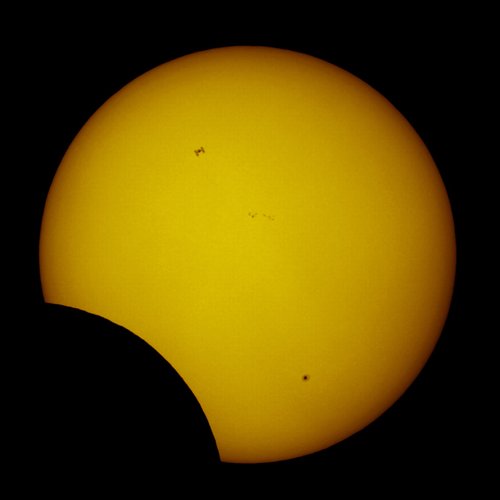 The big yellow ball is the sun, of course, and the black disk is the moon. In the lower right is a sunspot. But what's the speck in the upper left? Look closely. Resembles a TIE Fighter from Star Wars, no? It's actually the international space station, whooshing by at 17,000 mph at an altitude of 300 miles. Click on the pic for a much larger version, and details on how the shot was made.
The big yellow ball is the sun, of course, and the black disk is the moon. In the lower right is a sunspot. But what's the speck in the upper left? Look closely. Resembles a TIE Fighter from Star Wars, no? It's actually the international space station, whooshing by at 17,000 mph at an altitude of 300 miles. Click on the pic for a much larger version, and details on how the shot was made.
via Neatorama.
 The big yellow ball is the sun, of course, and the black disk is the moon. In the lower right is a sunspot. But what's the speck in the upper left? Look closely. Resembles a TIE Fighter from Star Wars, no? It's actually the international space station, whooshing by at 17,000 mph at an altitude of 300 miles. Click on the pic for a much larger version, and details on how the shot was made.
The big yellow ball is the sun, of course, and the black disk is the moon. In the lower right is a sunspot. But what's the speck in the upper left? Look closely. Resembles a TIE Fighter from Star Wars, no? It's actually the international space station, whooshing by at 17,000 mph at an altitude of 300 miles. Click on the pic for a much larger version, and details on how the shot was made.via Neatorama.
Tuesday, January 4, 2011
Winter Tour
I drove to Indy in two days, overnighting in (*shudder*) Zanesville, Ohio. I chose a route that takes me through as little of Maryland as possible: basically Maryland is the width of the Potomac River at that point, and you're out of West Virginia and into Pennsylvania in less than two minutes. Maryland doesn't even have a "Welcome To..." sign there, 'cause there's no place to stop.
The upside of the route is that it passes through Berkeley Springs, WV, a delightful little mountain town with some good local restaurants.
Arriving in Indianapolis, Tam showed me a great little gunshop in Brownsburg: Premiere Arms. And it's a pity that I didn't have my C&R updated with my new address, or I would've returned with something, I'm sure.
I was introduced to Huck The Cat, Roseholme's newest resident. What a character! The world's largest kitten.
New Year's Eve it was my privilege to escort the lovely Roberta X (airship privateer, TV techie and now, published author) to dinner at Morton's. We had the traditional champagne cocktails...worth waiting a year for!
I can report that I was favorably impressed with the new version of True Grit with Jeff Bridges, Matt Damon, Josh Brolin, Barry Pepper and little Hailee Steinfeld.
 Roberta, Tam, Brigid and I visited Artisano's Spices. You've GOT to at least sample some of their balsamic vinegars and spiced olive oils.
Roberta, Tam, Brigid and I visited Artisano's Spices. You've GOT to at least sample some of their balsamic vinegars and spiced olive oils. And speaking of spices, I was even allowed to sample the legendary Roseholme Hash! Spoiler alert: the secret is in the scissors.
And speaking of spices, I was even allowed to sample the legendary Roseholme Hash! Spoiler alert: the secret is in the scissors.The drive back was uneventful but scenic: the Tom Tom GPS unit reported heavy traffic on Rt 70 in Pennsylvania and re-directed me to state Route 30, a beautiful, winding rural highway. Then back through the same Hole In The Wall from Pennsylvania to West Virginia.
Stopping again at Berkeley Springs, I had lunch at Tari's Cafe. I ordered the special of the day, a Mediterranean Wrap. I wasn't expecting much, but it turned out to be one of the most delicious things I have ever tasted. Chicken, basmati rice (or maybe it was risotto?), artichoke hearts and secret ingredients, wrapped in a tortilla that is then toasted (or maybe it's baked). Wow! Highest recommendation.
The new embassy staff car, a 2002 Crown Victoria, performed beautifully. Preparing for the worst, I had mounted Michelin X-Ice snow tires on all four corners, and stocked the trunk with three MRE's (and chem-heaters for same), water, boots, socks, shovel, etc., etc. And the weather was some of the mildest I have ever encountered at this time of year. Murphy's Law, I guess!
Sunday, January 2, 2011
Titanic Big-End Bearing
At the Indiana State Museum, a recovered bearing from the Titanic. The inner diameter is about five feet. Roberta X also shown.
Saturday, January 1, 2011
Subscribe to:
Comments (Atom)



